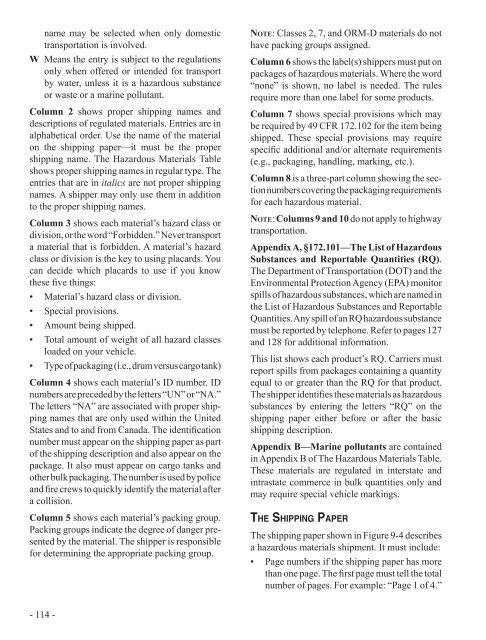Commercial Driver Handbook ( PDF ) - California Department of ...
Commercial Driver Handbook ( PDF ) - California Department of ...
Commercial Driver Handbook ( PDF ) - California Department of ...
Create successful ePaper yourself
Turn your PDF publications into a flip-book with our unique Google optimized e-Paper software.
name may be selected when only domestic<br />
transportation is involved.<br />
W Means the entry is subject to the regulations<br />
only when <strong>of</strong>fered or intended for transport<br />
by water, unless it is a hazardous substance<br />
or waste or a marine pollutant.<br />
Column 2 shows proper shipping names and<br />
descriptions <strong>of</strong> regulated materials. Entries are in<br />
alphabetical order. Use the name <strong>of</strong> the material<br />
on the shipping paper—it must be the proper<br />
shipping name. The Hazardous Materials Table<br />
shows proper shipping names in regular type. The<br />
entries that are in italics are not proper shipping<br />
names. A shipper may only use them in addition<br />
to the proper shipping names.<br />
Column 3 shows each material’s hazard class or<br />
division, or the word “Forbidden.” Never transport<br />
a material that is forbidden. A material’s hazard<br />
class or division is the key to using placards. You<br />
can decide which placards to use if you know<br />
these five things:<br />
• Material’s hazard class or division.<br />
• Special provisions.<br />
• Amount being shipped.<br />
• Total amount <strong>of</strong> weight <strong>of</strong> all hazard classes<br />
loaded on your vehicle.<br />
• Type <strong>of</strong> packaging (i.e., drum versus cargo tank)<br />
Column 4 shows each material’s ID number. ID<br />
numbers are preceded by the letters “UN” or “NA.”<br />
The letters “NA” are associated with proper shipping<br />
names that are only used within the United<br />
States and to and from Canada. The identification<br />
number must appear on the shipping paper as part<br />
<strong>of</strong> the shipping description and also appear on the<br />
package. It also must appear on cargo tanks and<br />
other bulk packaging. The number is used by police<br />
and fire crews to quickly identify the material after<br />
a collision.<br />
Column 5 shows each material’s packing group.<br />
Packing groups indicate the degree <strong>of</strong> danger presented<br />
by the material. The shipper is responsible<br />
for determining the appropriate packing group.<br />
- 114 -<br />
Note: Classes 2, 7, and ORM-D materials do not<br />
have packing groups assigned.<br />
Column 6 shows the label(s) shippers must put on<br />
packages <strong>of</strong> hazardous materials. Where the word<br />
“none” is shown, no label is needed. The rules<br />
require more than one label for some products.<br />
Column 7 shows special provisions which may<br />
be required by 49 CFR 172.102 for the item being<br />
shipped. These special provisions may require<br />
specific additional and/or alternate requirements<br />
(e.g., packaging, handling, marking, etc.).<br />
Column 8 is a three-part column showing the section<br />
numbers covering the packaging requirements<br />
for each hazardous material.<br />
Note: Columns 9 and 10 do not apply to highway<br />
transportation.<br />
Appendix A, §172.101—The List <strong>of</strong> Hazardous<br />
Substances and Reportable Quantities (RQ).<br />
The <strong>Department</strong> <strong>of</strong> Transportation (DOT) and the<br />
Environmental Protection Agency (EPA) monitor<br />
spills <strong>of</strong> hazardous substances, which are named in<br />
the List <strong>of</strong> Hazardous Substances and Reportable<br />
Quantities. Any spill <strong>of</strong> an RQ hazardous substance<br />
must be reported by telephone. Refer to pages 127<br />
and 128 for additional information.<br />
This list shows each product’s RQ. Carriers must<br />
report spills from packages containing a quantity<br />
equal to or greater than the RQ for that product.<br />
The shipper identifies these materials as hazardous<br />
substances by entering the letters “RQ” on the<br />
shipping paper either before or after the basic<br />
shipping description.<br />
Appendix B—Marine pollutants are contained<br />
in Appendix B <strong>of</strong> The Hazardous Materials Table.<br />
These materials are regulated in interstate and<br />
intrastate commerce in bulk quantities only and<br />
may require special vehicle markings.<br />
the shipping paper<br />
The shipping paper shown in Figure 9-4 describes<br />
a hazardous materials shipment. It must include:<br />
• Page numbers if the shipping paper has more<br />
than one page. The first page must tell the total<br />
number <strong>of</strong> pages. For example: “Page 1 <strong>of</strong> 4.”

















